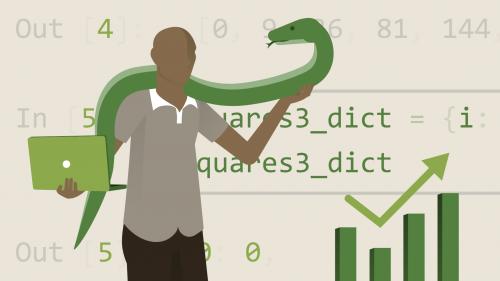Categories: Tutorials

Lynda - Python: Data Analysis (2015)
If you're going to work with big data, you'll probably be using R or Python. And if you're using Python, you'll be definitely using Pandas and NumPy, the third-party packages designed specifically for data analysis. This course provides an opportunity to learn about them. Michele Vallisneri shows how to set up your analysis environment and provides a refresher on the basics of working with data containers in Python. Then he jumps into the big stuff: the power of arrays, indexing, and DataFrames in NumPy and Pandas. He also walks through two sample big-data projects: one using NumPy to analyze weather patterns and the other using Pandas to analyze the popularity of baby names over the last century. Challenges issued along the way help you practice what you've learned. Topics include: Writing and running Python in iPython Using Python lists and dictionaries Creating NumPy arrays Indexing and slicing in NumPy Downloading and parsing data files into NumPy and Pandas Using multilevel series in Pandas Aggregating data in Pandas Skill Level Intermediate 2h 16m Duration 704,502 Views Show More Show Less - Hi, I'm Michele Vallisneri and I'd like to welcome you to Introduction to Data Analysis with Python. Data science has been described as intersection of programming, statistics and topical expertise. Python is an excellent programming tool for data analysis because it's friendly, pragmatic, mature and because it's complemented by excellent third party packages that were designed to deal with large amounts of data. We will start this course by reviewing Python data containers which are useful on their own and which set the model for the more powerful data objects of NumPy and Pandas. We will then put our knowledge of containers to work in a practical project. Then, we will talk about NumPy, the package that extends Python with a fast and efficient numerical array object. And we'll take NumPy out for a spin for a real data analysis project. Last, we will look at Pandas which is suitable for any kind of data and implements many ideas from the world of relational databases. We will use Pandas for its own practical project. So, let's get started with Introduction to Data Analysis with Python. Resume Transcript Auto-Scroll Q: The course shows how to download files from FTP and web servers using Python 3.X. How do I do the same thing with Python 2.7? A: First import urllib, then use urllib.urlretrieve(URL,filename). For instance, to download the stations.txt files used in the chapter 5 video “Downloading and parsing data files,” you’d do urllib.urlretrieve(‘ftp://ftp.ncdc.noaa.gov/pub/data/ghcn/daily/ghcnd-stations.txt','stations.txt'). Q. What are the issues with DataFrame.sort()? A: Since Pandas version 0.18, the DataFrame method sort() was removed in favor of sort_values(). Unlike sort(), the new method does not sort records in place unless it is given the option "inplace=True". The following lines of code in the video need changing:
Related Posts
Information
Members of Guests cannot leave comments.
Top Rated News
- Sean Archer
- AwTeaches
- Learn Squared
- PhotoWhoa
- Houdini-Course
- Photigy
- August Dering Photography
- StudioGuti
- Creatoom
- Creature Art Teacher
- Creator Foundry
- Patreon Collections
- Udemy - Turkce
- BigFilms
- Jerry Ghionis
- ACIDBITE
- BigMediumSmall
- Boom Library
- Globe Plants
- Unleashed Education
- The School of Photography
- Visual Education
- LeartesStudios - Cosmos
- All Veer Fancy Collection!
- All OJO Images
- All ZZVe Vectors




